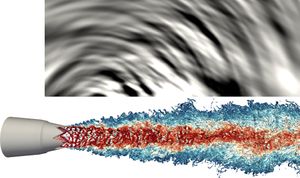UC3 - Mitigation of Aeroacoustic Noise
This use case targets the optimization of chevron nozzles to reduce noise emissions using a high-fidelity coupled flow-acoustics simulation approach.
Do you want to request support from EXCELLERAT staff or consulting on this Use Case?
*Registration is required to send inquiries.
Introduction
In this use case shape optimizations of chevron nozzles are performed, which is representative for problems with expensive objective function evaluations in the important technical field of noise reduction. It includes a constraint of minimum jet thrust loss, which has to be balanced with the goal of noise reduction. The accurate prediction of the emitted sound is based on a turbulence scale resolving CFD method, directly coupled with a computational aeroacoustics solver. The necessary large number of objective function evaluations can only be performed on exascale HPC systems. Additionally, highly refined and large scale simulations will be performed and advanced data analytics tools will be applied to the simulation results to analyse the noise mitigation effects of the chevrons.
The Challenge
The motivation for the use case is given e.g. by the Advisory Council for Aeronautical Research in Europe (ACARE), which established the Flightpath 2050, a new goal for more rigorous noise reduction by 65% relative to the capabilities of typical new aircraft in 2000. Despite the progressive introduction of high-bypass-ratio aircraft engines and chevron nozzles which possess a sawtooth-like shape at the engine’s trailing edge, jet noise still is a significant source of aircraft engine noise.
Aim
In the proposed use case the chevrons at the nozzle trailing edge region are optimized for noise reduction. During aircraft take-off and cruise flight, however, the chevron nozzle design can lead to a substantial and unwanted loss of thrust. Therefore, the primary objective is to establish an optimization workflow, which targets to optimize the geometry of chevrons such that the emitted jet noise from the aircraft engine is reduced with the constraint that the thrust is minimally affected.
Development
Unlike the optimization of the aerodynamic performance or structural weight, noise reduction is still to a large extent an unsolved problem. One of the challenges connected to noise reduction is a reliable and accurate prediction of the sound pressure level, which is often generated by intricate flow phenomena. Therefore, turbulence scale resolving simulations have to be performed in many cases to obtain the correct sound pressure level. At present, shape optimizations are not possible for such cases due to the computationally expensive evaluation of the objective function.
- The objective function, i.e. the sound pressure level constrained by the thrust loss, depends on various geometric parameters such as the chevron shape, number of chevrons, penetration angle, etc., the optimization requires a large number of noise predictions, which is computationally expensive.
- The noise prediction is based on a turbulence scale resolving simulation, hence gradients determined by adjoint formulations based on Automatic Differentiation (AD) do not exhibit asymptotic convergence. For the shape optimization therefore an Artificial intelligence-based optimization approach which requires O(1000) directly coupled computational fluid dynamics - computational aeroacoustics simulations is used.
- Using 500.000 cores of the Hawk system installed at HLRS, 100 simulation runs can be performed simultaneously.
- The simultaneous execution of the runs poses a significant challenge to the coordination of the optimizer and the computational resources.
- Since the AI-based optimization algorithm is directly fed with data from the simulation (in-situ) the simultaneous provision of large CPU/GPU resources is challenging.
Benefits
The established chevron nozzle optimization workflow will allow to optimisation of chevron nozzle designs for reduced noise emissions such that the thrust is minimally affected. Highly resolved simulations will be used for noise source identification and analysis of the impact of the chevron parameters on the generated noise. The developed workflow will also apply to other types of applications in the future.

